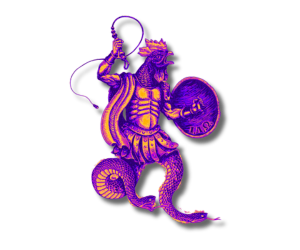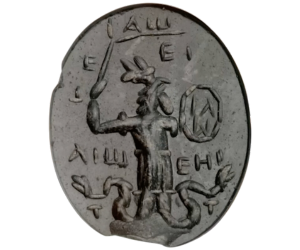How Yahweh Became a Donkey-Headed Egyptian Demon Called Set
- Dr. Darren M. Slade
- Feb 10, 2024
- 7 min read
One of the earliest known depictions of the crucifixion is a late second century etching called the Graffito of Alexamenos (also known as the “travesty crucifixion”), which appears on a marble slab and depicts a man (Alexamenos) worshipping a crucified person with the head of an ass. In Greek, the graffiti reads, “Alexamenos worships [his] God.” This graffiti intended to ridicule the early Christians’ worship of Jesus as a divine embodiment of Yahweh.

So why the head of an ass? What significance did a donkey's head have in the ancient world?
In the intellectual cauldron of the Greco-Roman world, a consensus prevailed among the diverse traditions that the cosmos, though not perfect, was the creation of a fundamentally good, beneficent being, designed with humanity's flourishing in mind. This belief spanned across the intellectual and spiritual divides, from Stoicism and Platonism to the emerging monotheistic religions. However, this intellectual harmony was destined to face a radical challenge, one that would unite disparate philosophies in shared dismay.
Mars riding a donkey from The Five Planets and Twenty-Eight Constellations, Liang dynasty
The Cosmos as a Living, Divine Being
Amidst the fervent blend of philosophy and mysticism that would eventually crystallize into Christianity, a revolutionary and controversial concept took shape:
the entire universe was seen as a prison, crafted not by a benevolent deity but by a malevolent entity—a Demiurge—driven by delusion and malice.
This Demiurge was known by various names, including Yaldabaoth (a lion-headed serpent responsible for ensnaring souls within physical forms) and Samael (the supreme ruler of demons, the harbinger of death, the consort of Lilith, and the foremost adversary of the archangel Michael).
Gnostic gem showing a lion-faced, serpentine deity.
Instead of being a manifestation of divine goodness, this new belief system viewed creation as a catastrophic error, the work of a demonic architect who was opposed to the Supreme Being's true perfection. But how did such an idea even come about? It was Plato's philosophy . . . duh! Specifically in his Timaeus, Plato offered a unique account of the universe's creation, posited as the work of a supremely good Demiurge, who (working with pre-existing but imperfect matter) endeavored to shape the universe based on immutable, heavenly Forms. Despite its inherent physical limitations, the cosmos was a living, divine entity (imbued with a soul).
A crucial aspect of this concept is the nature of matter itself. For Plato, matter is eternal, but it is also characterized by imperfection and changeability (in contrast to the eternal and unchanging nature of the Forms). This inherent imperfection means that while the cosmos can reflect the beauty and order of the Forms, it can never be perfect. The Demiurge's work is thus a process of ordering and structuring matter to reflect the Forms as closely as possible, but the resulting creation retains a degree of imperfection due to its physical nature.
Images of the archon-god Abraxas, who was believed by some early Christians to be "the power above all, and First Principle," "the cause and first archetype," and the deity who sent Christ into the world.
Other Gnostic groups believed Abraxas was the evil creator demon-god.
As such, the universe is the most beautiful and perfect creation possible under the circumstances, a testament to the Demiurge's skill and benevolence. In Plato's thinking, the universe itself is an object of reverence and a reflection of divinity, worthy of philosophical contemplation and study. The cosmos, in its structure and operations, invites humans to understand their place within this divine plan and to live in harmony with it.
Plato further explored the connection between the cosmos and human beings, suggesting that humans are a microcosm of the universe. Just as the cosmos is a living being with a soul, so too are humans, containing within themselves a reflection of the cosmic order. This analogy underscores the interconnectedness of all things and the idea that understanding the universe and its divine nature can help one understand the self (and vice versa).
How the Demiurge Became a Demon
The transformation of the Demiurge from a figure of maximal beneficence to one of malevolence was a complex process with no single origin point. However, his vilification likely stems from the confluence of various intellectual and religious traditions, including early Christian literature, Gnostic thought, and possibly the demonization of the Israelite god, Yahweh, among pagan circles. This latter association, which connected Yahweh to the Egyptian god Set, provided fertile ground for the reimagining of the creator Demiurge into a figure of darkness and tyranny.
Set with Nephthys
During the first few centuries before and after the Common Era, Judaism and its followers were spread throughout the Greek-speaking world, with a significant number residing in Alexandria, Egypt. Here, Alexandria was a melting pot of cultures and religions, including a sizable Jewish population that revered the Exodus story. When translated into Greek and orally performed in Alexandria, the book of Exodus would likely have been perceived as offensive by the Egyptians for multiple reasons:
The Exodus narrative portrays Egyptians as oppressors and adversaries of the Israelites, defeated by the God of Israel—who was originally El and then later became Yahweh. Such polemical portrayals would have been seen as derogatory to the Egyptian people and their cherished gods.
The Exodus narrative also undermines the power and authority of Egyptian deities by showcasing Yahweh's superiority in freeing the Israelites while performing numerous miracles, a plot device that would have been considered blasphemous and insulting to Egyptian religious sensibilities.
In other words, the Exodus story (and, thus, Jewish identity itself) casts the Egyptians in a decidedly dark and malevolent light. The story not only brands them as sorcerers and murderers, but it also frames their pantheon of gods as powerless before the might of a lone, foreign desert god—Yahweh. The Exodus story also subjugates their divine pharaoh to the role of mere pawn, destined for a watery grave (an end that was deemed ignominious within Egyptian religious thought). For the ancient Egyptians, drowning was not merely a death; it was a calamitous fate, making it an anathema to their understanding of a dignified transition to the afterlife.
For these Egyptians and other Gentiles, there was only one god who would create such disdainful mayhem: Set.
Yahweh and Set
In Egyptian mythology, Set was the god of chaos, deserts, storms, and was associated with violence and disorder. He is notorious for murdering his brother Osiris, dismembering him, and scattering the body parts. Osiris is a central figure in Egyptian religion, often associated with death, resurrection, and the afterlife. Hence, Set's role in Osiris's murder casts him as the primary antagonist within the Egyptian pantheon, embodying disorder and opposition to the beneficial rule and fertility that Osiris represented.
Seth and Horus
In response to an insulting Exodus story, many Egyptians equated Yahweh with Typhon (the Greek name for Set). This was a natural development considering several more factors:
Both Yahweh and Set had associations with storms and deserts. Yahweh's demonstrations of power in the Exodus narrative, like the plagues and parting of the Red Sea, could be likened to the chaotic and destructive aspects attributed to Set. For example, in Egyptian mythology, Set injured one of Horus' eyes. The sun was believed to be his good eye and the moon his injured eye. As the Pharaoh’s magicians noticed in Exodus 8:19, Yahweh's plague of gnats was “the finger of God." And yet, it was the finger of the Egyptian god Set that had been used to damage the “Eye of Horus.”
Set was also the god of foreigners and was associated with those chaotic elements outside the ordered Egyptian society. Yahweh, as the god of a foreign, nomadic people who had a contentious history with Egypt, fit into this category from an Egyptian perspective.
Beginning in the eighteenth century BCE, the Canaanite storm-god, Ba'al, was identified with Set. Set would also be equated with the Hittite god Teshub. Since Yahweh and Ba'al were two competing storm gods in the Levant, later merging into one deity in later Judaism, it was natural for people to equate Yahweh with Set.
To counter the negative portrayal of Egyptians in Exodus, some Egyptians responded by demonizing Yahweh, equating him with one of their most controversial gods, Set. This demonization included depicting Yahweh as a donkey-headed deity, drawing on Set's animalistic representations and further mocking the Jewish religion.
Set being worshipped by an Egyptian
This imagery of the donkey head became a focal point for religious slander, theological polemics, and cultural exchange, reflecting the deep-seated tensions and complex perceptions among ancient communities. By equating Yahweh with Set, certain Egyptian elements attempted to undermine the Israelite god's legitimacy and portrayed him as akin to a demon. This was a part of the broader context of Hellenistic cultural and religious polemics.
The Donkey Head as a Symbol of Slander
In Egyptian mythology, Set was often depicted with a donkey-like head. This association between Set and donkey imagery was leveraged in a derogatory manner against Jews (and later Christians) in Alexandria, where the multicultural milieu included a significant Jewish presence.

Donkey-headed deity, IAŌ, surrounded by the names Uriel, Suriel, Gabriel, and Michael.
The donkey, despite its usefulness, was often seen as a symbol of stubbornness and stupidity in various cultures, making the donkey imagery a powerful tool for religious and cultural slander. The accusation that Jews (and subsequently Christians) worshipped a donkey-headed god was a potent form of religious defamation aimed at undermining the legitimacy and dignity of their faith.
Prior to the "Southern Strategy" in the 1960s, the Democratic Party was actually the conservative party in American politics.
They have since become the liberal party but retained their original conservative symbol, the donkey.
Yahweh as an Evil Demiurge
In the emerging Christian tradition, the figure of Jesus Christ as the embodiment of divine wisdom and the true agent of salvation prompted a re-evaluation of Yahweh's role in the cosmic order. Marcion of Sinope, a significant figure in early Christianity, argued that the god of the Old Testament was not the true deity but, rather, a malevolent creator Demiurge. This view found echoes in various Gnostic texts where the Demiurge was depicted as a jealous, ignorant being who traps people's divine spark within decaying flesh.
The Canaanite deity, Ba'al, who became associated with Set.
The end result was a belief among many early Christians that Yahweh was, in fact, the evil Demiurge and not actually the Father God of Jesus Christ.
Conclusion
This association between Yahweh and Set reflects the complexities of cultural and religious interactions in the ancient world where gods could be appropriated, reinterpreted, or demonized based on inter-community relations. The conflation of Yahweh with Set contributed to the development of Gnostic thought, where the creator god (Demiurge) was increasingly seen in a negative light, eventually influencing early Christian interpretations of the Old Testament god as a being distinct from the benevolent Father of Jesus Christ.
The evolution of the Demiurge from a symbol of divine goodness to one of malevolence reflects the dynamic and often contentious nature of religious and philosophical thought in the ancient world. This shift underscores the profound impact of Gnostic ideas on the development of early Christian doctrine and highlights the intricate interplay between different intellectual and spiritual traditions.
.png)














